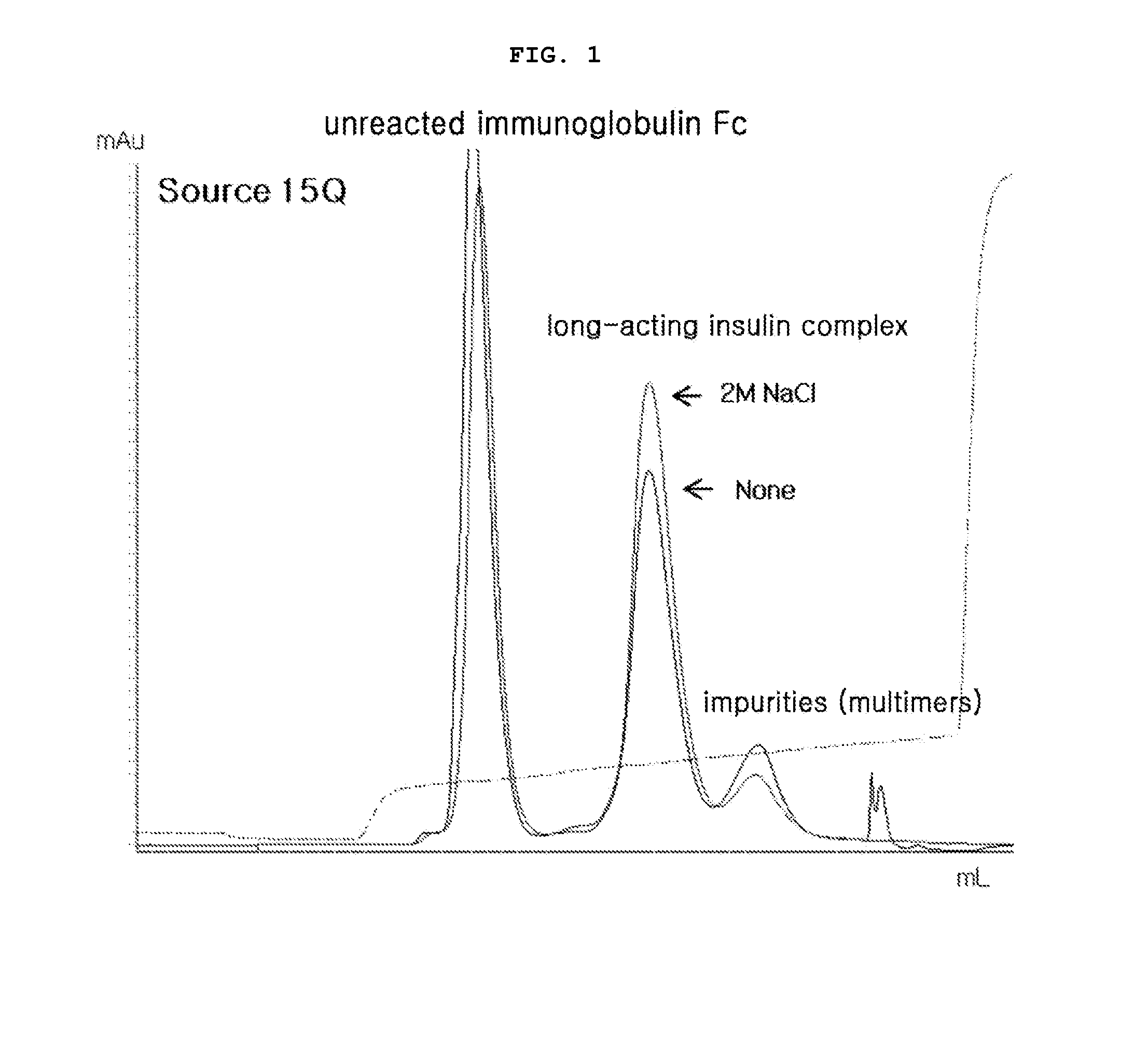Improved preparation method for high-yield production of physiologically active polypeptide conjugate
a polypeptide and conjugate technology, applied in the field of conjugate preparation, can solve the problems of high treatment cost, reduced potency of peptide drugs, and excessive suffering of patients, and achieve the effects of improving industrial applicability and drug compliance, high purity and yield, and reducing production costs
- Summary
- Abstract
- Description
- Claims
- Application Information
AI Technical Summary
Benefits of technology
Problems solved by technology
Method used
Image
Examples
example 1
PEGylation Reaction of Insulin and Purification of Mono-Pegylated Insulin
[0096]Insulin powder was dissolved in 10 mM HCl, and then reacted with 3.4K propion-ALD2 PEG (PEG having two propionaldehyde groups at both ends, IDB, Korea) at 4° C. for about 2 hours at a molar ratio of 1:4 of insulin:PEG and an insulin concentration of 5 mg / ml to pegylate the N-terminal of the insulin beta chain. This reaction was conducted under 50 mM sodium citrate pH 6.0, in 45% isopropanol with addition of 3.0 mM sodium cyanoborohydride, a reducing agent. The reaction solution was purified with SP-HP (GE Healthcare) column using a buffer containing sodium citrate (pH 3.0) and 45% EtOH, and a KCl concentration gradient.
example 2
Preparation of Conjugate by Coupling Reaction without Salt Addition
[0097]To prepare a conjugate of insulin-PEG-immunoglobulin Fc fragment, mono-PEGylated insulin prepared by the method of Example 1 and an immunoglobulin Fc fragment were reacted at a molar ratio of 1:1.2 with a total protein level of 20 mg / ml at 25° C. for 13 hours. At this time, the reaction solution contained 100 mM HEPES, 22 mM potassium phosphate, and 10% ethanol at pH 8.2, and further contained 20 mM sodium cyanoborohydride as a reducing agent.
[0098]After completion of the reaction, the reaction solution was passed through Source 15Q (GE Healthcare) column to separate and purify the unreacted insulin, the unreacted immunoglobulin Fc fragment, the conjugate of insulin-PEG-immunoglobulin Fc fragment, and the conjugate of immunoglobulin Fc fragment coupled with two or more mono-PEGylated insulin (insulin-PEG) using Tris-HCl (pH 7.5) buffer and a NaCl concentration gradient. In this regard, the content of impurities...
example 3
Improvement of Coupling Reaction Yield by Addition of Sodium Chloride
[0100]To examine the effect of sodium chloride on the coupling reaction yield, mono-PEGylated insulin prepared by the method of Example 1 and the immunoglobulin Fc fragment were reacted at a molar ratio of 1:1.2 with a total protein level of 20 mg / ml at 25° C. for 13 hours. At this time, the reaction solution contained 100 mM HEPES, 22 mM potassium phosphate, and 10% ethanol at pH 8.2 with addition of sodium chloride to a final concentration of 0.5 to 3.0 M, and further contained 20 mM sodium cyanoborohydride as a reducing agent.
[0101]The reaction solution was purified and analyzed in the same manner as in Example 2. The addition of sodium chloride to the coupling solution improved the coupling reaction yield, compared to no addition. This effect was maximized by addition of sodium chloride with a final concentration of 2.0 M (Table 1). The results of Source 15Q profile showed that impurities due to a side reaction...
PUM
| Property | Measurement | Unit |
|---|---|---|
| Temperature | aaaaa | aaaaa |
| Time | aaaaa | aaaaa |
| Molar density | aaaaa | aaaaa |
Abstract
Description
Claims
Application Information
 Login to View More
Login to View More - R&D
- Intellectual Property
- Life Sciences
- Materials
- Tech Scout
- Unparalleled Data Quality
- Higher Quality Content
- 60% Fewer Hallucinations
Browse by: Latest US Patents, China's latest patents, Technical Efficacy Thesaurus, Application Domain, Technology Topic, Popular Technical Reports.
© 2025 PatSnap. All rights reserved.Legal|Privacy policy|Modern Slavery Act Transparency Statement|Sitemap|About US| Contact US: help@patsnap.com

